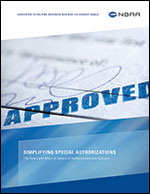Aug. 2, 2017

While listening to membership feedback, representatives of NBAA’s Domestic Operations Committee noticed one commonly reported issue: the complex, often challenging process of acquiring Letters of Authorization (LOA).
In NBAA’s resource, Simplifying Special Authorizations (PDF), the committee provides practical advice to make this process easier and more likely to result in an authorization meeting the operator’s needs.
“The general rule is, the better prepared you are and the more complete your package is, the better response you’re going to get,” said David Norton, partner at Shackelford, Bowen, McKinley & Norton, and primary author of the guide. Here are a few tips from the resource that can help you with acquiring a timely LOAs.
1. Know where to look
“One of the issues people find is that LOAs change over time; there’s no definitive list saying these are the LOAs you need,” said Norton. “You have to really parse through things to figure out what you need, and each one is a little different because they’re very fact-specific.”
With this ambiguity, it’s critical that operators know where they can research the necessary information for their paperwork. NBAA’s new resource includes a list of the most commonly applicable regulations and where they can be found in the Flight Standards Information System (FSIMS), a repository of all flight standards policy and guidance concerning aviation safety inspector job tasks.
2. Assemble a complete and professional application package
Even with the proper information, operators shouldn’t expect that FAA officials will be able to read their mind and hand back exactly what they need. Norton applies the “garbage in, garbage out” philosophy to authorization applications – the less complete and cohesively arranged your package is, the less likely you are to receive what you need in a timely manner.
“You need to do the homework and understand what it is you’re asking for,” said Norton. “You have an obligation to tell the FAA exactly, for example, who the operator is, what you’re doing, what equipment you have – it’s your job to put together the information they need to process the request, not the other way around.”
3. Work with your FSDO throughout the process
Ultimately, the authorization process is one of professional interaction with representatives of a local Flight Standards District Office (FSDO). Streamlining their review process by submitting a polished application will give you the best chance of a quicker, more favorable response. To facilitate this, Norton recommended hand-delivering the package, if possible, and periodically following up with FSDO in a professional manner.
“If you make their job easy – giving them the what they need the first time, making it clear you’re available to quickly address any questions – that’s how you give FAA the tools to quickly respond to what you’re asking for,” said Norton.


 International Business Aviation Council Ltd.
International Business Aviation Council Ltd.